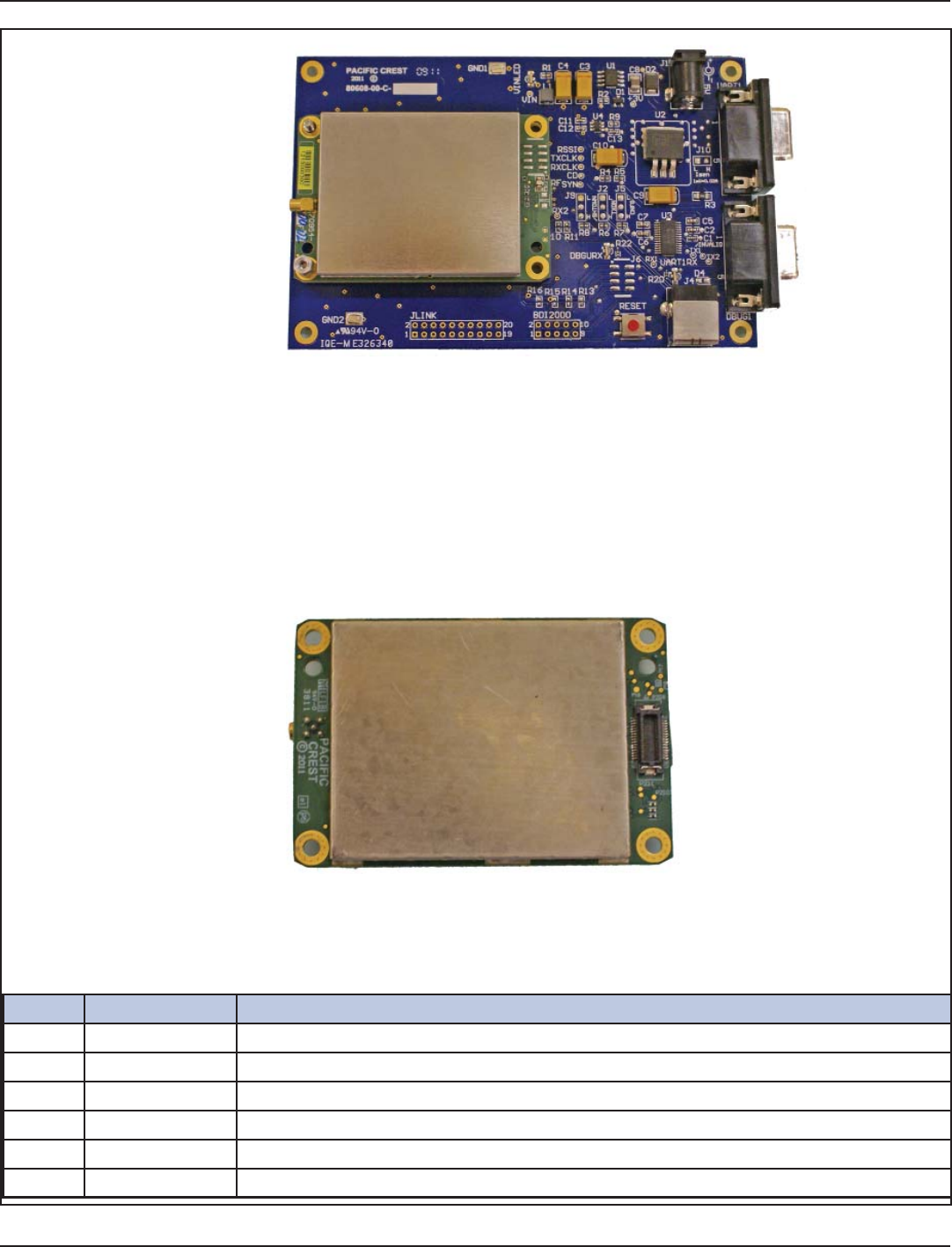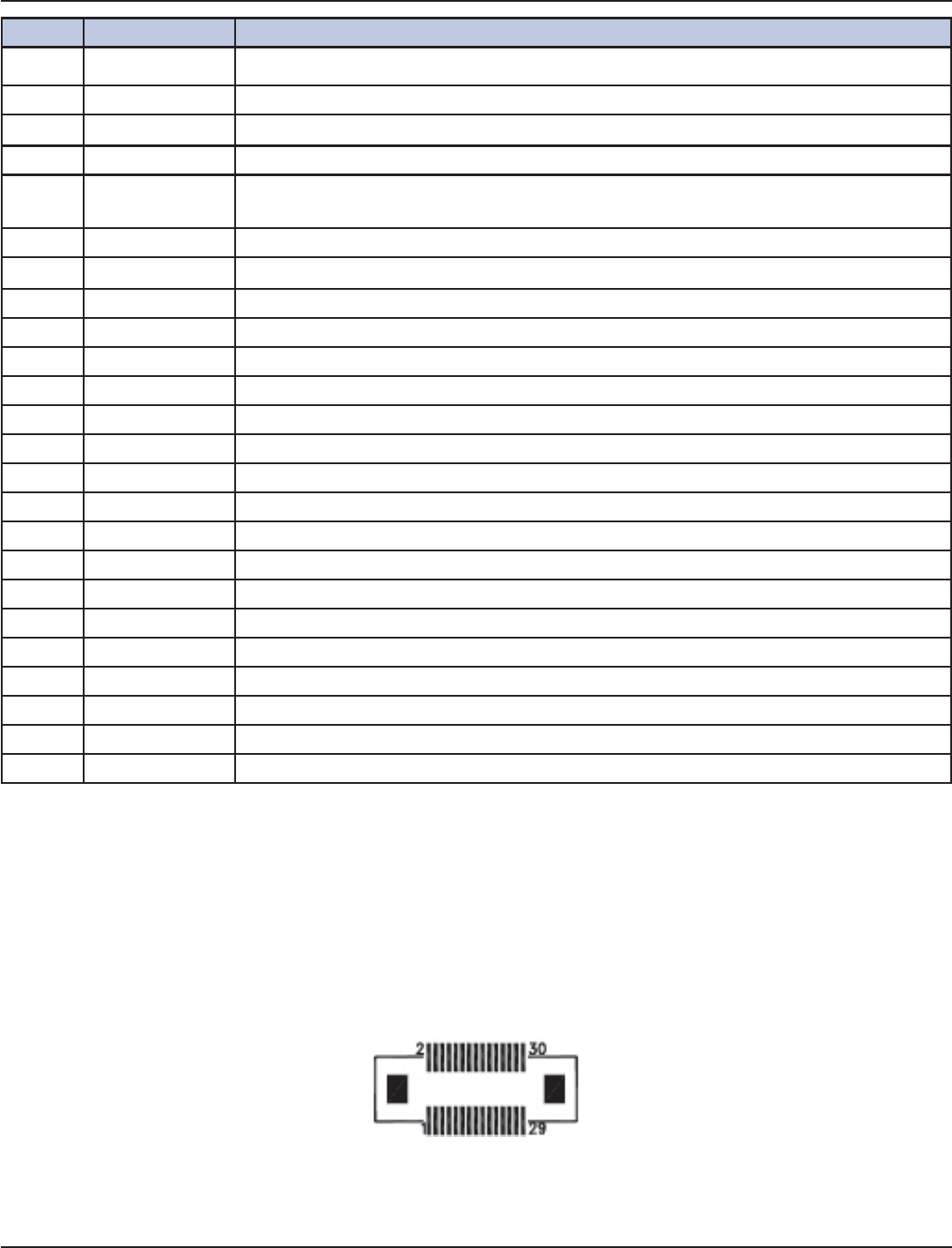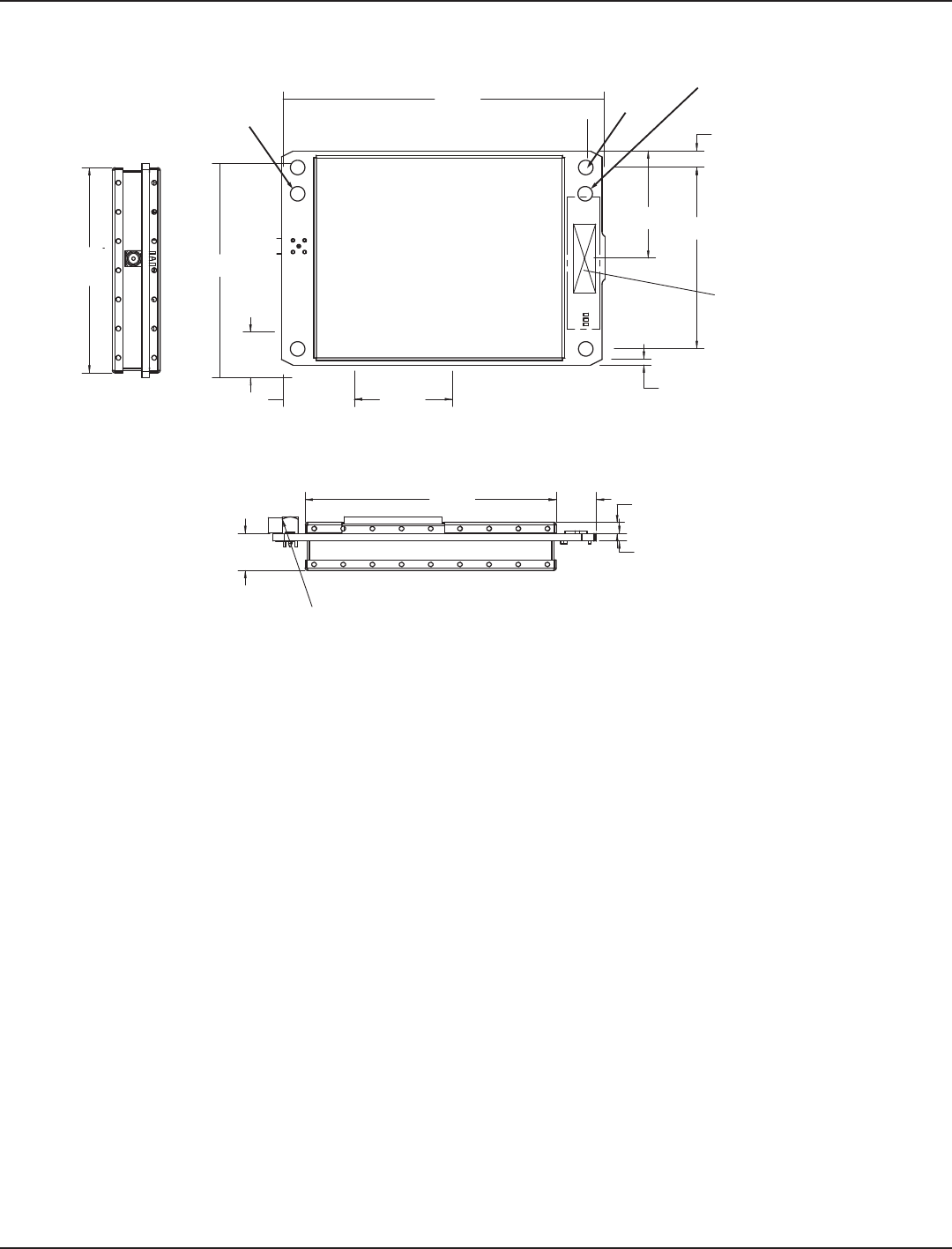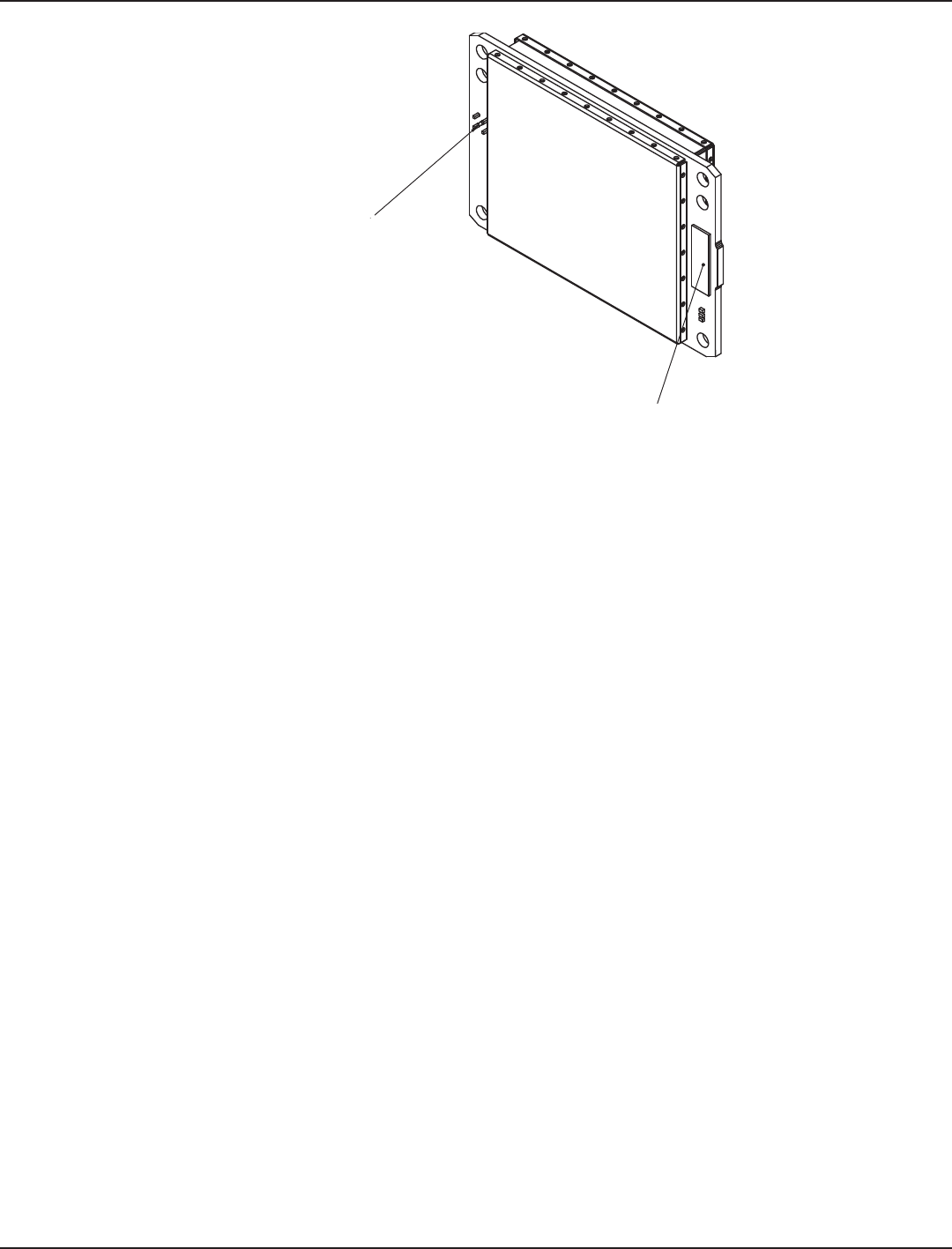Trimble Navigation XDLM UHF Transceiver Module User Manual TDL 450i Integrator s Guide 03 2012 indd
Trimble Navigation Ltd UHF Transceiver Module TDL 450i Integrator s Guide 03 2012 indd
Contents
- 1. Users Manual Part One
- 2. Users Manual Part Two
Users Manual Part One

INTEGRATOR'S GUIDE
Trimble® TDL 450i

AMERICAS & ASIA-PACIFIC
Trimble Navigation Ltd.
Integrated Technologies
510 DeGuigne Drive
Sunnyvale, CA 94085
USA
+1-408-481-8070 Phone
+1-408-481-8984 Fax
EUROPE & MIDDLE EAST
Trimble Navigation Ltd.
Integrated Technologies
HAL Trade Center
Bevelandseweg 150
1703 AX Heerhugowaard
Netherlands
+31-725-724-408 Phone
+31-725-348-288 Fax
RUSSIA
Trimble Navigation Ltd.
Integrated Technologies
Tel: +7 495 5041081
Email: rusales-pc@trimble.com
CHINA
Trimble Navigation Ltd.
Integrated Technologies
311 Fute (M) Road, 3/F
Wai Gaoqiao Free Trade Zone
Pudong, Shanghai 200131
China
Email: chinasales-pc@trimble.com

TDL 450i Intergrator’s Guide 3
Contact Information
Support hours are 8 am to 5 pm Paci c Time. Please visit our website for up-to-date
news and product announcements. Firmware and software upgrades are available
from our website, usually free of charge.
Legal notices
©2012, Trimble Navigation Limited. All rights reserved. SATEL is a registered
trademark of SATEL Oy. Trimble is a trademark of Trimble Navigation Limited,
registered in the United States and in other countries. TRIMMARK and TRIMTALK
are trademarks of Trimble Navigation Limited. Microsoft, Windows, and Windows
Vista are either registered trademarks or trademarks of Microsoft Corporation in
the United States and/or other countries. All trademarks are the property of their
respective owners.
Warranty
One-Year limited warranty
is warranty gives you speci c legal rights. You may also have other rights which
vary from state to state or area to area.
Trimble warrants TDL family products, inclusive of cables and batteries, against
defects in materials and workmanship for a period of one year from receipt by the
end-user.
Exclusions
Should Trimble be unable to repair or replace the product within a reasonable
amount of time, a refund of the purchase price may be given upon return of the
product.
e warranty on your radio shall not apply to defects resulting from:
• Improper or inadequate maintenance by the customer
• Unauthorized modi cation, negligence, or misuse
• Operation outside of the environment speci cations
Warranty limitations
is warranty set forth above is exclusive and no other warranty, whether written or
oral, is expressed or implied. Trimble speci cally disclaims the implied warranties of
merchantability and tness for a particular purpose.
Notices
Class B Statement – Notice to Users. is equipment has been tested and found to
comply with the limits for a Class B digital device, pursuant to Part 15 of the FCC
rules. ese limits are designed to provide reasonable protection against harmful
interference in a residential installation. is equipment generates, uses, and can
radiate radio frequency energy and, if not installed and used in accordance with
the instructions, may cause harmful interference to radio communication. However,
there is no guarantee that interference will not occur in a particular installation.
If this equipment does cause harmful interference to radio or television reception,
which can be determined by turning the equipment o and on, the user is encouraged
to try to correct the interference by one or more of the following measures:
• Reorient or relocate the receiving antenna.
• Increase the separation between the equipment and the receiver.
• Connect the equipment into an outlet on a circuit di erent from that to which the
receiver is connected.
• Consult the dealer or Trimble directly for help.
Changes and modi cations not expressly approved by the manufacturer or registrant
of this equipment can void your authority to operate this equipment under Federal
Communications Commission rules.
Canada
is digital apparatus does not exceed the Class B limits for radio noise emissions
from digital apparatus as set out in the radio interference regulations of the Canadian
Department of Communications.
Le présent appareil numérique n’émet pas de bruits radioélectriques dépassant les
limites applicables aux appareils numériques de Classe B prescrites dans le règlement
sur le brouillage radioélectrique édicté par le ministère des Communications du
Canada.
Europe
is product has been tested and found to comply with the requirements for a Class
B device pursuant to European Council Directive 1999/5/EC on R&TTE,
thereby satisfying the requirements for CE Marking and sale within the
European Economic Area (EEA). ese requirements are designed to
provide reasonable protection against harmful interference when the
equipment is operated in a residential or commercial environment, and
to ensure that the equipment is safe.
Australia and New Zealand
is product conforms with the regulatory requirements of the
Australian Communications and Media Authority (ACMA) EMC
framework, thus satisfying the requirements for C-Tick Marking and
sale within Australia and New Zealand.
Notice to Our European Union Customers
For product recycling instructions and more information, please go to
www.trimble.com/ev.shtml.
Recycling in Europe: To recycle Trimble WEEE (Waste Electrical and
Electronic Equipment, products that run on electrical power.), Call +31
497 53 24 30, and ask for the “WEEE Associate”. Or, mail a request for
recycling instructions to:
Trimble Europe BV
c/o Menlo Worldwide Logistics
Meerheide 45
5521 DZ Eersel, NL
Trimble Navigation Limited
Integrated Technologies
510 DeGuigne Drive
Sunnyvale, CA 94085
USA
1-408-481-8070 Phone
1-800-795-1001 (USA toll free)
1-408-481-8982 Fax
www.trimble.com

TDL 450i Intergrator’s Guide 4
Safety Information
Before you use your radio, ensure that you have read and understood this publication, as well as safety
requirements.
CAUTION – A license is required before operating radio communication equipment.
Warnings and cautions
An absence of specific alerts does not mean that there are no safety risks involved.
Always follow the instructions that accompany a Warning or Caution. The information they provide is
intended to minimize the risk of personal injury and/or damage to the equipment. In particular, observe
safety instructions that are presented in the following formats:
WARNING – A Warning alerts you to a likely risk of serious injury to your person and/or damage to the
equipment. A warning identifies the nature of the risk and the extent of possible injury and/or damage. It also
describes how to protect yourself and/or the equipment from this risk. Warnings that appear in the text are
repeated at the front of the manual.
CAUTION – A Caution alerts you to a possible risk of damage to the equipment and/or loss of data. A Caution
describes how to protect the equipment and/or data from this
Exposure to radio frequency energy
The radio is designed to comply with the following national and international standards and guidelines
regarding exposure of human beings to radio frequency electromagnetic energy, in addition to protection
against harmful interference of neighboring electrical equipment:
• FCC Report and Order FCC 96-326 (August, 1996)
• American National Standards Institute (C95.3-1992)
• National Council on Radiation Protection and Measurement (NCRP - 1986)
• International Commission on Non-ionizing Radiation Protection (ICNRP - 1986)
• European Committee for Electrotechnical Standardization (CENELEC)
• FCC CFR47 Part 15
• FCC CFR47 Part 90
• Industry Canada RSS 119
• ETSI EN 300 113-2
• ETSI EN 300 489
• ACA AS/NZS 4295
• iDA Spec 111
• OFTA STD-1E
• RRC CMII
Contact your sales representative for model specific country approval.
To assure optimal radio performance and to ensure that exposure to RF energy is within the guidelines in
the above standards, observe the following operating procedures:
• Do not operate a transceiver when someone is within the distance noted below of the antenna (unity
gain).
–45 cm (approximately 12 in) for the TDL 450i/

TDL 450i Intergrator’s Guide 5
–15 cm (approximately 6 in) for the TDL 450i radio @ 1 W
• Do not operate the transceiver unless all RF connectors are secure and any open connectors are properly
terminated.
• Avoid contact with the antenna while operating the transceiver.
• Do not operate the transceiver with a damaged antenna. If a damaged antenna comes in contact with
the skin, a minor burn may result.
• Do not operate the equipment near electrical blasting caps or in an explosive atmosphere.
CAUTION – Changes or modifications not expressly approved by the FCC could void the user’s authority to
operate the equipment.
FCC Rules and Regulations
Licensing requirements
It is the responsibility of the owner to comply with applicable rules and regulations concerning the
operation of a radio transmitter. In the United States, the FCC regulates the licensing of this equipment.
Application for a license is made by submitting FCC Form 600 along with evidence of frequency
coordination (if required) and applicable fees. Similar licensing requirements exist worldwide. Penalties for
broadcasting without a license can be severe, and may include the confiscation of your radio.
For more information, contact our customer service department.
WARNING – Always obey local licensing requirements and restrictions. It is illegal to transmit in the United
States while CSMA is turned off. CSMA is not required within the European Union and should be turned off.
Equipment compliances
The radios have been tested and found to comply with Parts 15 and 90 of Title 47 of the Code of Federal
Regulations. They have also been tested and found compliant for type certification and approval in many
other countries worldwide.
For more information concerning our worldwide compliances, contact customer support.
Being part of the RF community
Operation of a licensed radio product makes you a member of the RF community. Be aware that virtually all
frequencies licensed are provided on a shared basis with other users. Each frequency dedicated specifically
to RTK surveying activities has certain restrictions and limitations. For complete information, refer to the
appropriate documentation from the licensing agency in your country of operation, e.g., Part 90, Title 47, of
the Code of Federal Regulations.
Most frequencies sharing data transmissions and voice transmissions give priority to voice users. Be
mindful of the persistent nature of a GPS RTK data transmission and always limit your RF transmission
output power when performing close-in survey situations to avoid interference with co-channel users.
Trimble recommends using the low RF power setting for construction site and other line-of-site surveys
with baselines less than two miles (depending on terrain).
WARNING – If you are in conflict with a co-channel user, select another frequency to avoid formal actions
by government agencies. In most cases, you are required to vacate a frequency upon complaint by a shared
channel voice user.
Most survey operations are itinerant in that the system is moved on a frequent basis. For fixed system

TDL 450i Intergrator’s Guide 6
installations, you should not use frequencies set aside for itinerant operations, but should coordinate a
frequency based on the fixed area operation.
Regulations differ from country to country, please be aware of the local regulations before using radio
equipment.
Automatic station identification
For operation in the United States, the FCC requires that radio transmitters broadcast a station identifier
every 15 minutes. The station identifier is the call sign assigned to you on the station license.
The radios support the broadcast of station identification in a manner that meets the requirements of
the FCC. Upon receipt of equipment, use the XDLCONF software to program your FCC call sign into the
configuration of the radio. This is only required for transmitters.
The call sign is transmitted every 15 minutes in Morse code. It is not included in any data packet and so is
not processed by the receiving radio. However, data transmission is interrupted for a few seconds while the
call sign is being transmitted. If you leave the Call sign field blank (on the XDLCONF Identification screen),
the radio programmed with this configuration file will not transmit any call sign.
WARNING – Failure to transmit your station identification is in violation of FCC regulations. If you are
operating outside the United States, check with the local authorities if you need to transmit a call sign.
Carrier Sense Multiple Access (CSMA)
CSMA is a technology implemented in the radios to meet the United States Federal Communication
Commission (FCC) transmitter requirements. It is illegal to transmit on any UHF radio within the United
States without CSMA enabled. CSMA holds off the radio transmission if the frequency is currently being
used by a co-channel user. On occasion, you may note that the radio broadcasts stop for short periods of
time. Most often, this is a case of co-channel interference and the radio is holding off broadcasts due to the
FCC-mandated CSMA.
Note – You should turn CSMA off when transmitting within the European Union.
GPS RTK equipment is designed to function with intermittent gaps in the data. Heavy co-channel use may
limit the ability of the radio to transmit the required information. In areas of heavy co-channel usage, try
changing channels to a less used frequency.

TDL 450i Intergrator’s Guide 7
Contents
Safety Information . . . . . . . . . . . . . . . . . . . . . . . . . . . . . . . . . . . . . . . . . . . . . . . . . . . . . . 4
Introduction . . . . . . . . . . . . . . . . . . . . . . . . . . . . . . . . . . . . . . . . . . . . . . . . . . . . . . . . . . . 8
Getting Started. . . . . . . . . . . . . . . . . . . . . . . . . . . . . . . . . . . . . . . . . . . . . . . . . . . . . . . . . 8
Interface Port Pin Out . . . . . . . . . . . . . . . . . . . . . . . . . . . . . . . . . . . . . . . . . . . . . . . . . . . . . . . . . . . . . . . . . . . . . . . . . 9
TX and RX Pins. . . . . . . . . . . . . . . . . . . . . . . . . . . . . . . . . . . . . . . . . . . . . . . . . . . . . . . . . . . . . . . . . . . . . . . . . . . 10
Antenna Port . . . . . . . . . . . . . . . . . . . . . . . . . . . . . . . . . . . . . . . . . . . . . . . . . . . . . . . . . . . . . . . . . . . . . . . . . . . . 11
Compliance . . . . . . . . . . . . . . . . . . . . . . . . . . . . . . . . . . . . . . . . . . . . . . . . . . . . . . . . . . . . . . . . . . . . . . . . . . . . . . . . . 11
Compatibility . . . . . . . . . . . . . . . . . . . . . . . . . . . . . . . . . . . . . . . . . . . . . . . . . . . . . . . . . . . . . . . . . . . . . . . . . . . . . . . . 11
Protocols and Modes of Operation . . . . . . . . . . . . . . . . . . . . . . . . . . . . . . . . . . . . . . . 11
Electrical Considerations . . . . . . . . . . . . . . . . . . . . . . . . . . . . . . . . . . . . . . . . . . . . . . . . 13
Power Supply . . . . . . . . . . . . . . . . . . . . . . . . . . . . . . . . . . . . . . . . . . . . . . . . . . . . . . . . . . . . . . . . . . . . . . . . . . . . . . . . 13
CMOS Input/Output Protection Circuitry . . . . . . . . . . . . . . . . . . . . . . . . . . . . . . . . . . . . . . . . . . . . . . . . 13
Error Codes . . . . . . . . . . . . . . . . . . . . . . . . . . . . . . . . . . . . . . . . . . . . . . . . . . . . . . . . . . . . . . . . . . . . . . . . . . . . . . . . . . 14
Shielding Considerations . . . . . . . . . . . . . . . . . . . . . . . . . . . . . . . . . . . . . . . . . . . . . . . . . . . . . . . . . . . . . . . . . . . . 14
Frequency Planning . . . . . . . . . . . . . . . . . . . . . . . . . . . . . . . . . . . . . . . . . . . . . . . . . . . . . . . . . . . . . . . . . . . . . . . . . . 14
Mechanical Considerations . . . . . . . . . . . . . . . . . . . . . . . . . . . . . . . . . . . . . . . . . . . . . . 15
EMI interferers . . . . . . . . . . . . . . . . . . . . . . . . . . . . . . . . . . . . . . . . . . . . . . . . . . . . . . . . . . . . . . . . . . . . . . . . . . . . . . 15
Shock and Vibration. . . . . . . . . . . . . . . . . . . . . . . . . . . . . . . . . . . . . . . . . . . . . . . . . . . . . . . . . . . . . . . . . . . . . . . . . . 15
ermal Transfer. . . . . . . . . . . . . . . . . . . . . . . . . . . . . . . . . . . . . . . . . . . . . . . . . . . . . . . . . . . . . . . . . . . . . . . . . . . . . 15
Materials . . . . . . . . . . . . . . . . . . . . . . . . . . . . . . . . . . . . . . . . . . . . . . . . . . . . . . . . . . . . . . . . . . . . . . . . . . . . . . . . . . . . 16
Service and Support . . . . . . . . . . . . . . . . . . . . . . . . . . . . . . . . . . . . . . . . . . . . . . . . . . . 16
Philosophy . . . . . . . . . . . . . . . . . . . . . . . . . . . . . . . . . . . . . . . . . . . . . . . . . . . . . . . . . . . . . . . . . . . . . . . . . . . . . . . . . . 16
Phone/Internet Support . . . . . . . . . . . . . . . . . . . . . . . . . . . . . . . . . . . . . . . . . . . . . . . . . . . . . . . . . . . . . . . . . . . . . 16
Warranty . . . . . . . . . . . . . . . . . . . . . . . . . . . . . . . . . . . . . . . . . . . . . . . . . . . . . . . . . . . . 16
One-Year Limited Warranty . . . . . . . . . . . . . . . . . . . . . . . . . . . . . . . . . . . . . . . . . . . . . . . . . . . . . . . . . . . . . . . . . . 16
Exclusions . . . . . . . . . . . . . . . . . . . . . . . . . . . . . . . . . . . . . . . . . . . . . . . . . . . . . . . . . . . . . . . . . . . . . . . . . . . . . . . . . . . 17
Warranty Limitations . . . . . . . . . . . . . . . . . . . . . . . . . . . . . . . . . . . . . . . . . . . . . . . . . . . . . . . . . . . . . . . . . . . . 17
Appendix A - Mounting Guide . . . . . . . . . . . . . . . . . . . . . . . . . . . . . . . . . . . . . . . . . . . 17
Standard Enclosure . . . . . . . . . . . . . . . . . . . . . . . . . . . . . . . . . . . . . . . . . . . . . . . . . . . . . . . . . . . . . . . . . . . . . . . . . . 17
Appendix B - Cables and Connectors . . . . . . . . . . . . . . . . . . . . . . . . . . . . . . . . . . . . . . 19
Value-Added Cable Products . . . . . . . . . . . . . . . . . . . . . . . . . . . . . . . . . . . . . . . . . . . . . . . . . . . . . . . . . . . . . . . . . 19
Interface Connector . . . . . . . . . . . . . . . . . . . . . . . . . . . . . . . . . . . . . . . . . . . . . . . . . . . . . . . . . . . . . . . . . . . . . . . . . . 19
RF Connector . . . . . . . . . . . . . . . . . . . . . . . . . . . . . . . . . . . . . . . . . . . . . . . . . . . . . . . . . . . . . . . . . . . . . . . . . . . . . . . . 19
Appendix C - Technical Specifi cations . . . . . . . . . . . . . . . . . . . . . . . . . . . . . . . . . . . . . . 20
Appendix D – API Commands . . . . . . . . . . . . . . . . . . . . . . . . . . . . . . . . . . . . . . . . . . . . 21

TDL 450i Intergrator’s Guide 8
Introduction
This guide provides information concerning the integration of the TDL 450i radio modem transceiver into
your product (Model Numbers XDLM-0, XDLM-1 and XDLM-2). This guide should be used in conjunction
with the XDLCONF User’s Guide – Dealer Version that should be referenced for general information
concerning the configuration of TDL 450i modems, and also for detailed programming information.
The TDL 450i is a general-purpose radio modem transceiver that is compatible with TRIMMARK radios,
the Advanced Data Link (ADL) and the Positioning Data Link (PDL) product families of radio modems. The
TDL 450i transceiver is designed specifically for integration into existing or new products. Its small size,
light weight and power efficient operation provide superior performance in embedded systems.
Getting Started
Caution: TDL 450i transceiver must be handled with care during installation. Remove the transceiver from its
protective bag only in an ESD safe area.
To set up the hardware components, follow these steps:
1. Plug the TDL 450i transceiver into an I/O-test board’s 20-pin connector
2. Attach an antenna cable to the TDL 450i transceiver
3. Attach a PC interface cable to a 9-pin UART connector on the I/O-test board
4. Attach the PC interface cable to a serial port on your PC
5. Attach a wall cable to the AC/DC adapter and select the proper plug from the adapter kit
6. Attach the AD/DC adapter’s tubular plug to the power jack on the I/O-test board
7. Plug in an XDLCONF or XDLCONF (Dealer’s Version) USB key on your PC
8. Download and install the latest Sentinel driver for the USB key from http://www.safenet-inc.
com/support/tech/latestdriver.asp
9. Launch XDLCONF and refer to its user guide for instructions on connecting to the TDL 450i
transceiver

TDL 450i Intergrator’s Guide 9
TDL 450i in Test Board
Interface Port Pin Out
The standard TDL 450i transceiver comprises a 30-pin port for power, data and interfacing with other
electronic devices.
30 Pin TDL 450i Board
The following signals are available on the 30-pin connector:
Pin Name Description
1 GND GROUND FOR SIGNAL AND POWER
2 DO NOT USE FACTORY USE ONLY, NO CONNECTION
3 TX TX DATA, DTE SERIAL PORT, 3V CMOS (3.3V COMPATIBLE)
4 DO NOT USE FACTORY USE ONLY, PLEASE NO CONNECTION
5 GND GROUND FOR SIGNAL AND POWER
6 DO NOT USE FACTORY USE ONLY, PLEASE LEAVE NO CONNECTION

TDL 450i Intergrator’s Guide 10
Pin Name Description
7 GND GROUND FOR SIGNAL AND POWER
8 DO NOT USE FACTORY USE ONLY, PLEASE LEAVE NO CONNECTION
9 GND GROUND FOR SIGNAL AND POWER
10 DO NOT USE FACTORY USE ONLY, PLEASE LEAVE NO CONNECTION
11 CONFIG I/O TO FORCE RADIO SWITCH BETWEEN OPERATING MODE AND
CONFIGURATION MODE
12 DO NOT USE FACTORY USE ONLY, PLEASE LEAVE NO CONNECTION
13 DO NOT USE FACTORY USE ONLY, PLEASE LEAVE NO CONNECTION
14 RX RX DATA, DTE SERIAL PORT, 3V CMOS (3.3V COMPATIBLE)
15 DO NOT USE FACTORY USE ONLY, PLEASE LEAVE NO CONNECTION
16 DO NOT USE FACTORY USE ONLY, PLEASE LEAVE NO CONNECTION
17 DO NOT USE FACTORY USE ONLY, PLEASE LEAVE NO CONNECTION
18 VCC POWER IN
19 GND GROUND FOR SIGNAL AND POWER
20 GND GROUND FOR SIGNAL AND POWER
21 GND GROUND FOR SIGNAL AND POWER
22 GND GROUND FOR SIGNAL AND POWER
23 VCC POWER IN
24 VCC POWER IN
25 VCC POWER IN
26 VCC POWER IN
27 VCC POWER IN
28 VCC POWER IN
29 POWER POWER DOWN RADIO
30 GND GROUND FOR SIGNAL AND POWER
TX and RX Pins
Pin 3 is used by the TDL 450i module to received data from an external device (a PC, GPS receiver,
weather sensor, etc). Pin 14 is used to transmit data to the external device. The external device is
transmitting data to the TDL 450i on Pin 3, so according to the DTE naming convention, Pin 3 is
called the “TX Data” pin. The external device receives data from the TDL 450i’s Pin 14 so this is called
the “RX Data” pin.
Pin Orientation

TDL 450i Intergrator’s Guide 11
Antenna Port
A coaxial antenna port is provided for connecting the antenna system to the TDL 450i transceiver.
The antenna connector is a 50-Ohm MMCX type. Appendix B provides part numbers and
manufacturer information for compatible interface and RF connectors. Pacific Crest also provides
custom manufactured cables designed to your specific needs. Contact us for a quotation for your
specific cabling requirements.
Warning: Don’t transmit without first connecting an antenna.
Compliance
The TDL 450i transceiver radio modem is designed to be compliant with worldwide regulatory
requirements, including FCC part 90, ETS 300-113-2, IC RSS 119 and others.
Warning: The TDL 450i transceiver is classified as an intentional radiator of type radio transceiver.
Conducted and radiated emissions of the standard TDL 450i transceiver do not exceed the requirements
of FCC part 90 and ETS 300-113-2. OEM is responsible for full compliance of final product.
Compatibility
The TDL 450i transceiver is compatible with most modes of operation supported by the TDL, ADL
and PDL product families of radio modems. See the Protocols and Modes of Operation section for an
overview of the protocols and modes that are supported with the TDL 450i transceiver radio modem.
The compatibility also extends to XDLCONF software configuration program and the ADL Test
application that are supplied as part of the TDL 450i Developer’s Kit.
Protocols and Modes of Operation
The TDL 450i transceiver radio modem is completely configurable using XDLCONF software.
Configuration parameters define the DTE interface and the over-the-air protocol. Depending on the
application you may need to change the factory default settings. The following table shows the factory
default configuration of the TDL 450i transceiver.
Parameter Default
Channel 1
Baud Rate 38400
Parity None
Soft Break Disable Off
TX Power 0.5 W
Mode Transparent EOT Timeout

TDL 450i Intergrator’s Guide 12
Parameter Default
Link Rate 9600 bps GMSK
EOT 50 ms
Repeater Delay 0
CSMA On*
FEC On
Scrambling On
Sensitivity High
Local Address 0
Destination Address 255
*CSMA is required to be on only inside the United States. You should turn CSMA off in EU countries.
TDL 450i Factory Default Settings
Up to 32 frequencies are stored in the configuration memory called the channel table. The selection of
channel is subject to proper licensing of the corresponding frequencies by the appropriate governmental
agency. Please refer to the XDLCONF User’s Guide for instructions in creating and uploading channel tables
into the TDL 450i transceiver modem.
The TDL 450i transceiver modem supports multiple protocols and modes of operation including:•
• Transparent with EOT Timeout
• Transparent with EOT Character
• TRIMTALK™ 450S
• TRIMTALK II/IIE
• TT450S (HW)
• TRIMMARK™ 3
• SATEL®
• Transparent FST
Refer to the XDLCONF User’s Guide for a detailed description.

TDL 450i Intergrator’s Guide 13
Electrical Considerations
Power Supply
The TDL 450i transceiver has a power supply connection on Pin 18 and Pins 23 to 28 of the interface
connector. Pins 1, 5,7, 9,30 and Pins 19 to 22 are connections to both power ground and serial interface
signal grounds. Note that these pins are tied to a common point on the TDL 450i transceiver. If there is a
potential for a ground path current loop due to improper power application, we recommend a fusible link
be inserted in the signal ground to protect the TDL 450i transceiver.
TDL 450i transceiver modems are designed to operate with unregulated DC voltage levels between 3.6 and
4VDC. The power supply must be capable of sourcing 2A.
Data Interface
TDL 450i transceiver provides one data port, which has a simple 3-wire CMOS electrical interface with
signals for transmitting data to and receiving data from the TDL 450i transceiver, and for providing a
reference ground for the TX (Pin 3) and RX (Pin 14) signals.
Note: We define TX and RX as a DTE port. In other words, an external device transmits data to the radio
modem’s TX pin (Pin 3) and receives data from the radio modem’s RX pin (Pin 14).
CMOS Input/Output Protection Circuitry
The TX signal terminates into a CMOS input port on the TDL 450i transceiver and should be driven
externally or pulled to ground through a 10 kΩ resistor. The absolute maximum voltage applied to the TX
signal is -0.3 V to 3.3 V.
The signals are CMOS outputs. Note that loading the RX signals increases the power consumption of the
TDL 450i transceiver and these should be limited to no more than 2.5 mA each to maintain performance
across the temperature range.
Caution: Internal circuitry protects the inputs and outputs against damage caused by high static voltages or
electric fields; however, normal precautions are necessary to avoid application of any voltage higher than the
maximum-rated voltages.

TDL 450i Intergrator’s Guide 14
Error Codes
The TDL 450i transceiver performs a variety of power-up and run-time tests to assure optimal operation.
Tests include environmental as well as electrical measurements designed to avoid damage to the unit while
maintaining adequate operation.
A 50Ω impedance coaxial MMCX style RF connector is provided for attachment to an external antenna
system. The MMCX connector offers a positive friction locking mechanism that is very reliable. In some
circumstances, it may be required to provide a physical stop to prevent the MMCX plug from becoming
disconnected due to extreme shock or vibration.
The TDL 450i transceiver requires an antenna and feed cable system that is impedance- matched to 50Ω.
We recommend that high quality RG-178 or equivalent coaxial cable be used for internal wiring of the RF
signal from the MMCX to the panel connector. We also suggest the selection of an antenna that has a low
VSWR (less than 1.5:1) and that has been tuned for operation in the band of the TDL 450i transceiver.
Caution: Improper impedance matching of the antenna, connectors or cable will degrade the performance of
the TDL 450i transceiver.
Shielding Considerations
The TDL 450i transceiver is designed to operate in proximity to noise generating circuitry. However, certain
radiated or conducted frequencies may degrade the performance of the TDL 450i transceiver or render it
inoperable. When possible, provide well-grounded shielding between circuits that radiate, such as power
supplies, voltage-controlled oscillators, crystal oscillators and the TDL 450i transceiver.
Frequency Planning
The TDL 450i transceiver contains a very sensitive, dual-conversion super-heterodyne receiver.
Caution: Radiated and conducted signals to and from the TDL 450i transceiver may cause problems due to
interference. Proper attention to frequency planning may reduce interference from radiated or conducted
frequencies that fall within the pass-bands of the filters at the IF frequencies.
We recommend the use of upfront analysis of the product frequency plan (including harmonics) and then
the use of a spectrum analyzer to determine the potential for interference within the pass-bands of the
various front-end and band pass filters.
The following table indicates the frequencies and band pass filter characteristics that are areas of potential
interference.
Circuit Center Frequency (MHz) Bandwidth (MHz)
RF front-end 438 70

TDL 450i Intergrator’s Guide 15
Circuit Center Frequency (MHz) Bandwidth (MHz)
First IF 54.45 0.015
Second IF 0.450 0.010
TDL 450i Frequency Plan
Mechanical Considerations
EMI interferers
The TDL 450i transceiver is easily mounted inside new and existing products. The TDL 450i
transceiver is specifically designed for operation in harsh environments. For best performance,
mount the radio away from potential EMI radiators and route RF signals apart from digital signals.
Caution: We do not recommend the bundling of the antenna interface cable with other signal cables
internal to your product.
Shock and Vibration
Sensitive radio transceivers, such as the TDL 450i transceiver, are susceptible to interference due
to mechanical shock and vibration. To reduce the potential for electromechanical interference, a
robust mounting scheme must be used when being integrated into other systems. A thin damping
pad between the mounting surface and the TDL 450i transceiver may be required. We recommend
the use of damping pads made of PORON(R) or a similar material.
Thermal Transfer
The TDL 450i transceiver requires additional thermal heat dissipation in order to supply maximum
power out at elevated ambient temperatures and high duty cycles. The TDL 450i transceiver has
a thermal sensor and a firmware controlled limit switch. The TDL 450i will shut down when the
PCB temperature reaches 85°C to prevent permanent damage to transmitter. The integrated heat
sink is adequate for most bench top testing but when the TDL 450i transceiver is integrated into
other systems additional thermal heat sinking must be considered. The TDL 450I will produce

TDL 450i Intergrator’s Guide 16
approximately 6 Watts of heat at full RF power out.
Refer to Appendix A for mounting diagrams and specification.
Materials
The TDL 450i transceiver is housed in a metal shield that is a conductor and is electrically connected to the
ground and signal ground pins.
Service and Support
Philosophy
Pacific Crest is dedicated to providing the very best service and support possible. We recognize that the
success of our business is directly related to the success our customers have in using our products. For this
reason, we provide easy access with our toll free number, which we encourage our customers to use if they
are experiencing difficulties or problems with the products we supply.
Let us know what you think. A cornerstone of our business philosophy is to evolve our product lines to
match the needs of our customers. Your input allows us to better determine what we need to do to keep our
product and support offerings in alignment with your needs.
Phone/Internet Support
Phone support is available during our business hours, Monday through Friday (7 a.m. to 4 p.m. Pacific
Standard Time). Call 1-800-795-1001 (U.S. and Canada), +1-408-481-8070 (International),
+1-408-481-8984 (Fax). You can contact the support group via our web site, www.PacificCrest.com or send
an e-mail to support@pacificcrest.com
Warranty
One-Year Limited Warranty
This warranty gives you specific legal rights. You may also have other rights which vary from state to state
or province to province.

TDL 450i Intergrator’s Guide 17
Pacific Crest warrants its TDL 450i transceiver radio modem products against defects in materials and
workmanship for a period of one year from receipt by the end user. During the warranty period, Pacific
Crest will, at its option, either repair or replace products that prove to be defective.
Exclusions
Should Pacific Crest be unable to repair or replace the product within a reasonable amount of time, a refund
of purchase price may be given upon return of the product.
The warranty on your TDL 450i transceiver radio modem shall not apply to defects resulting from:
• Improper or inadequate maintenance by the customer
• Unauthorized modification or misuse
• Operation outside of the environmental specifications for the product
• Negligence or misuse
Warranty Limitations
The warranty set forth above is exclusive and no other warranty, whether written or oral, is expressed or implied.
Pacific Crest specifically disclaims the implied warranties of merchantability and fitness for a particular
purpose.
Appendix A - Mounting Guide
Standard Enclosure
The figure below shows mounting holes locations and overall dimensions for the TDL 450i transceiver.
Caution: Screws used to mount the TDL 450i transceiver to a mounting plate must not penetrate the mounting
surface of the TDL 450i transceiver by more than 0.20 inches. Screws that penetrate beyond this distance may
cause damage.

TDL 450i Intergrator’s Guide 18
[21.34]
.840
[9.91]
.390
[46.61]
1.835
[69.85]
2.750
[15.57]
.613
[1.27]
.050
[39.50]
1.555
[23.37]
.920
[3.56]
.140
[44.65]
1.758
RF CONNECTOR
RIGHT ANGLE MMCX
[8.05]
.317
[54.66]
21.52
[8.74]
.344 [2.39]
.094
[1.63]
.064
TEST FIXTURE TOOLING HOLE
DO NOT USE FOR MOUNTING
TEST FIXTURE TOOLING HOLE
DO NOT USE FOR MOUNTING
[3.18]
4x 0.125
KEEPOUT AREA BOTH SIDES
COMPONENTS AND TEST POINTS
LOCATED HERE
.100 INCH MINIMUM CLEARANCE
TDL 450i Mounting Template

TDL 450i Intergrator’s Guide 19
RF CONNECTOR
RIGHT SIDE MMCX
FARSIDE
DATA CONNECTOR AVX
TDL 450i Mounting Template with Shields
Appendix B - Cables and Connectors
Value-Added Cable Products
Pacific Crest manufactures a wide variety of high-quality custom cables in support of its OEM customers.
Contact your Pacific Crest sales representative to discuss your custom cable requirements.
Interface Connector
The 30-pin data/power header is a Samtec TFM series housing a standard-configuration connector, AVX
part number 14-5046-030-630-829. The mating Samtec connector is part number 24-5046-030-600-829 for
a board-to-board interface See AVX website: http://www.samtec.com and www.AVXcorp.com for other
mating connector options.
RF Connector

TDL 450i Intergrator’s Guide 20
The RF connector is compatible with an MMCX-style coaxial plug. Plugs are available from many sources
and in many configurations. We use plugs manufactured by Radiall. Radiall MMCX right-angle plug for use
with RG-178 cable is part number R110 172 100. Radiall MMCX straight plug for use with RG-178 cable is
part number R110 083 120.
Appendix C - Technical Specifications
General
DTE - DCE interface
User Interface
CMOS, 115.2 kbps maximum
Low Profile 30 Pin Connector, Refer to Pin-Outs
Power requirements
External 3.6 VDC ± 0.05mV
During Rx 0.45 W nominal @ 3.6 VDC
During Tx 6.5 W nominal @ 3.6 VDC, 2 W RF output
Radio
Frequency band 403-473 MHz
Frequency control Synthesized 12.5 kHz tuning resolution
Frequency stability +/- 1PPM
Channel spacing Channel spacing 12.5/25 kHz (user-selectable)
RF transmitter output 0.5, 1.0 or 2 Watt (Programmable)
Sensitivity -110 dBm BER = 1 x 10-5
Adjacent channel
selectivity
>50dB
Type certification All models will be type accepted and certified for operation in the
U.S., Europe, Australia, New Zealand, and Canada
FCC, IC, EU, NZ, Australia ETS300-113-2
Modem
Link Rate/Modulation 4-Level FSK: 9600, 19,200 bps
GMSK: 4800, 8000, 9600, 16,000, 19,200 bps
Link Protocols Transparent EOT/EOC/FST, SATEL, TRIMTALK II/IIe, TRIMMARK3,
TRIMTALK 450S
Forward Error Correction
(FEC) and Detection
Yes
Environmental
Shock and vibration Per MIL-STD-810F
Ambient temperature
range
Operating temperature
(receiver)
-40 ˚C to +85 ˚C (-40 ˚F to +185 ˚F)
Operating temperature
(transmitter)
-40 ˚C to +65 ˚C (-22 ˚F to +149 ˚F)
Storage temperature -55 ˚C to +85 ˚C (-67 ˚F to +185 ˚F)
Mechanical
Dimensions 69.8 mm L x 46.6 mm W x 11.2 mm H
2.750” L x 1.835” W x 0.442” H
Weight 1.4 oz (40 grams)

TDL 450i Intergrator’s Guide 21
Appendix D – API Commands
A description of the TDL 450i transceiver Application Programmer Interface is available to qualified Pacific
Crest development partners. Please contact sales@PacificCrest.com.